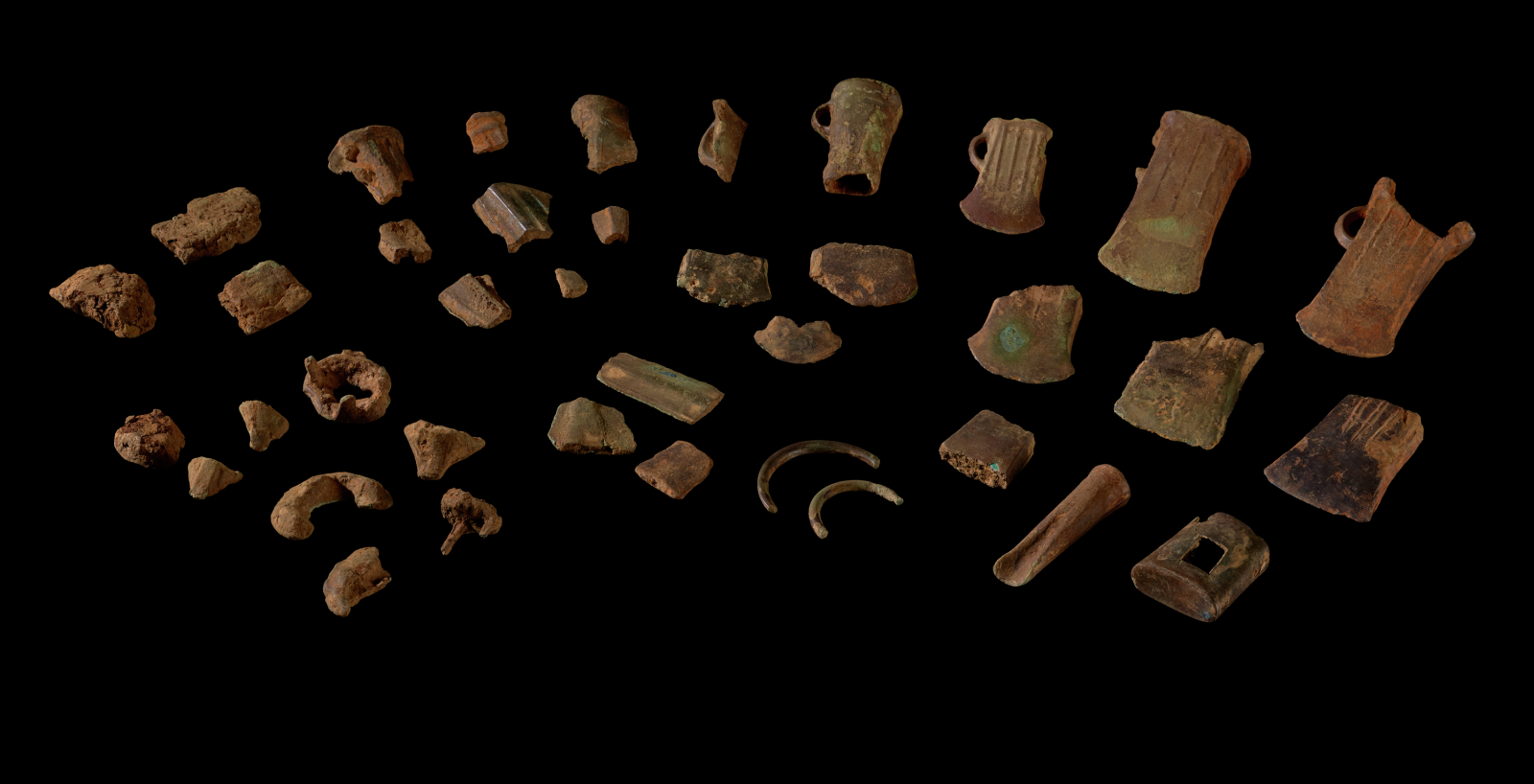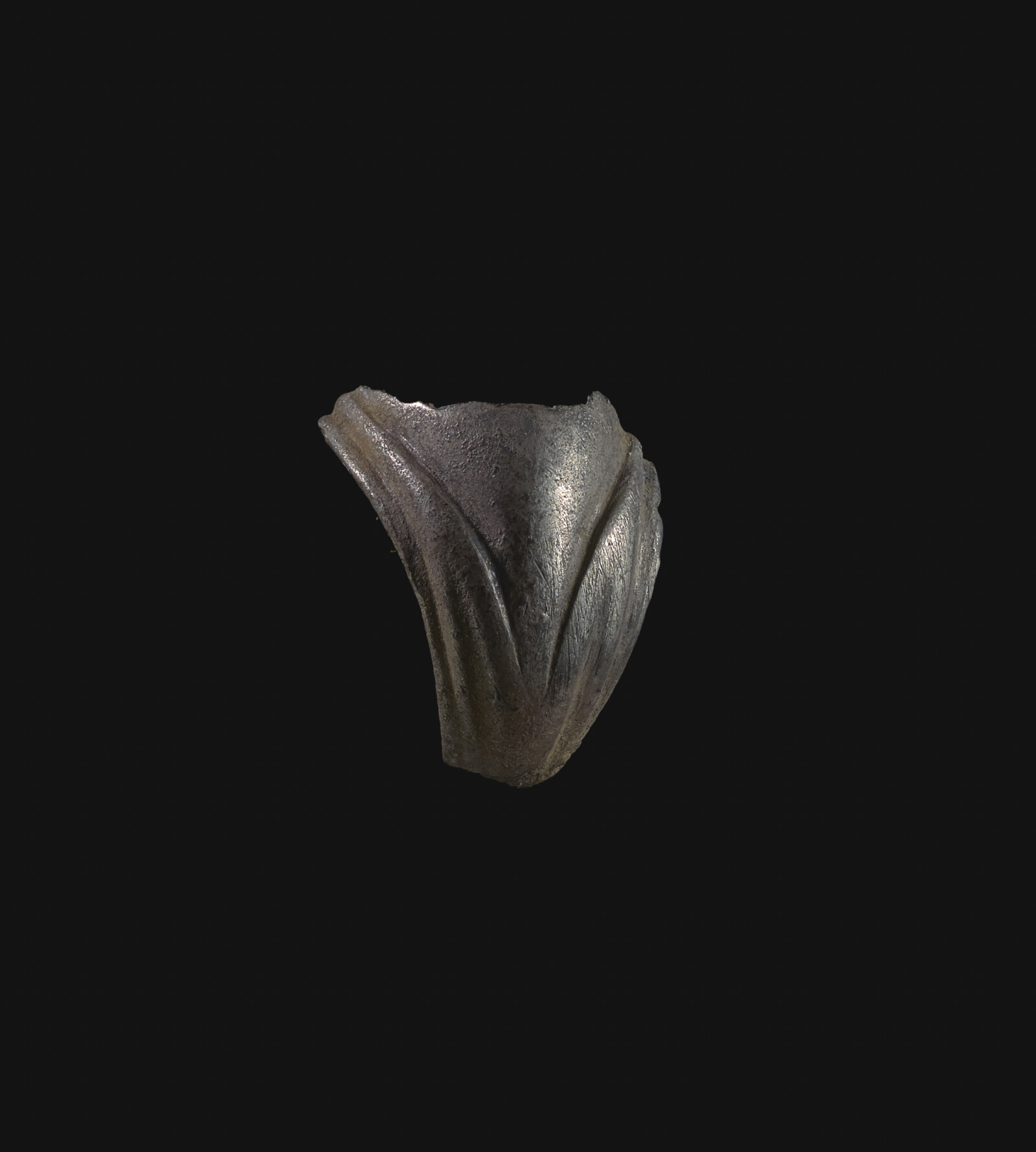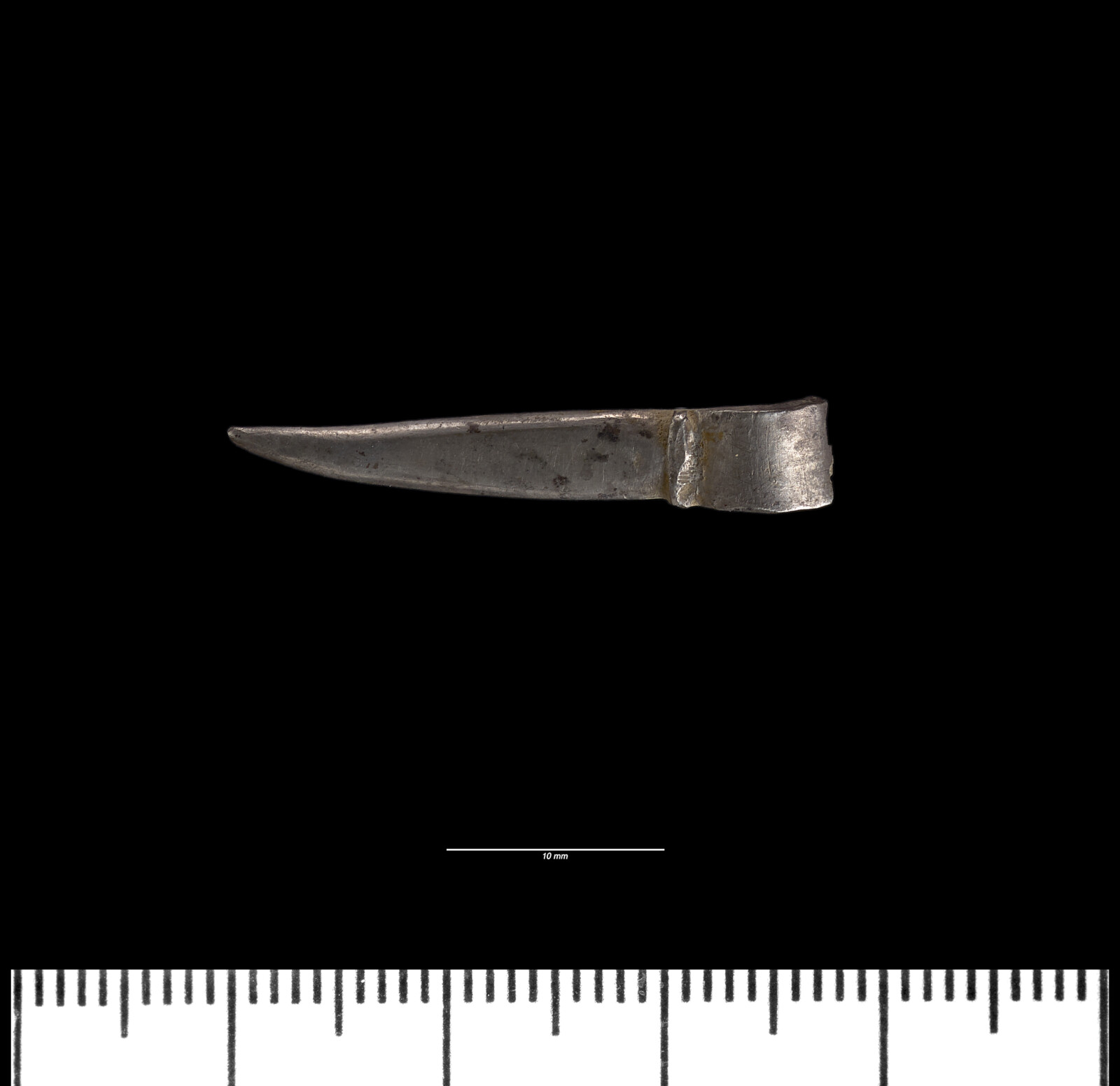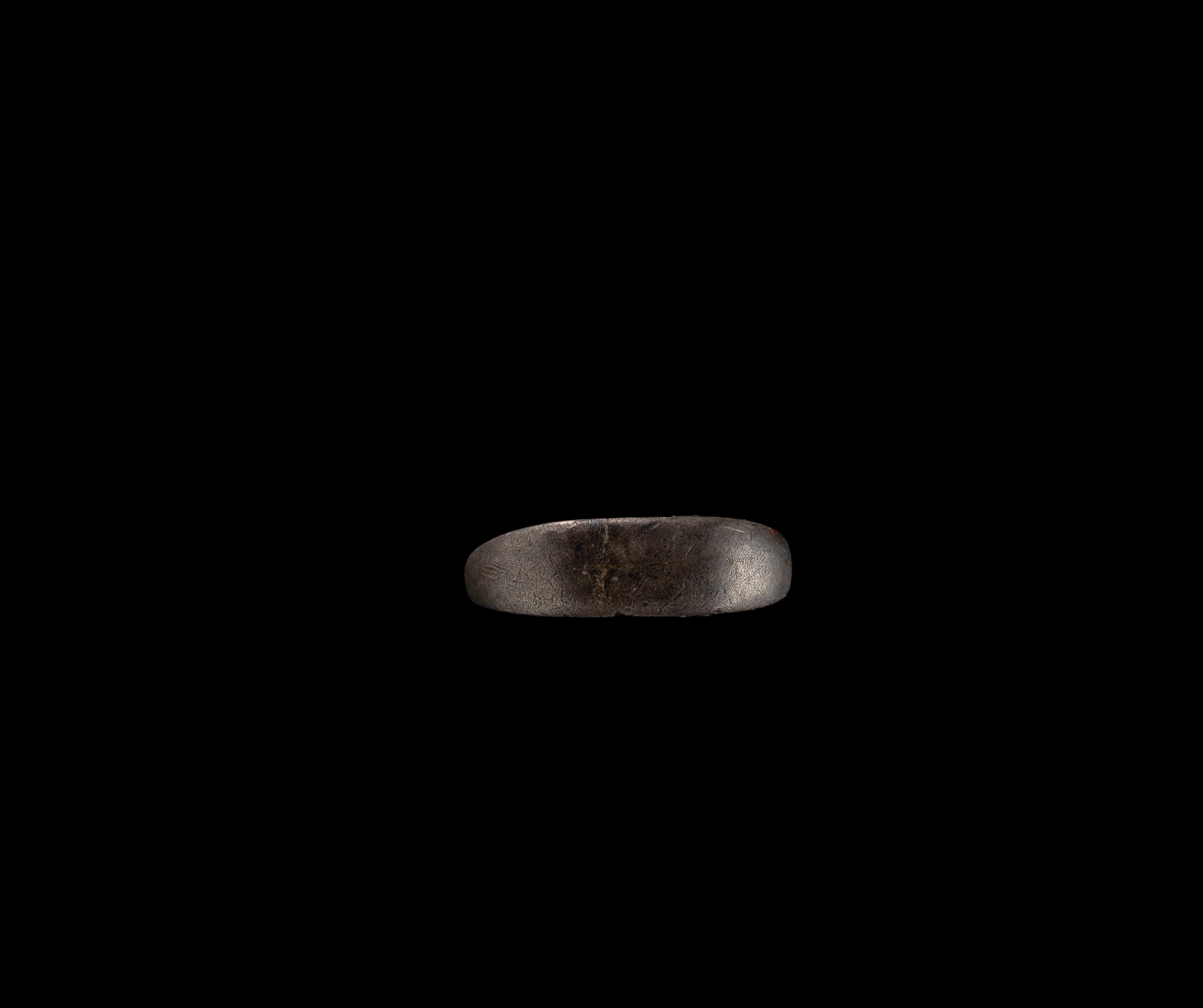Press Releases
Treasure found in South Wales and Powys
Date:
2023-11-14Four treasure finds, including a Bronze Age hoard, two Roman silver finger-rings and a medieval silver brooch pin were declared treasure on Tuesday 14th November 2023 by Area Coroner for South Wales Central, Patricia Morgan.

Late Bronze Age hoard

Roman silver finger-ring fragment

A medieval silver brooch pin

Roman silver finger-ring fragment
These finds were reported by finders to Mark Lodwick and Dr Susie White, of the Portable Antiquities Scheme for Wales (PAS Cymru), who first identified them as being possible treasure finds.
A Late Bronze Age hoard (Treasure Case 21.24) was discovered by Dr Peter Anning and Alex Evans on 2nd February 2021, after agricultural drainage work that had been undertaken in a field in St Fagans Community, Cardiff. The hoard comprises fragments of 38 bronze artefacts, including socketed axes, spearheads, a diverse range of casting-jets and ingot fragments. Amongst the more unusual objects are a chape fitting from the base of a sword scabbard, a socketed gouge for woodworking and two case bronze rings, possibly used as horse-harness fittings.
The hoard dates to between 1000 and 800 BC and was probably deliberately buried within an isolated pit in the ground. The metal could easily have been re-smelted into new bronze objects, therefore the decision to bury the objects instead was deliberate. It is likely that these bronze objects were gathered together by a local community and buried during a ritual ceremony which expressed the social customs and religious beliefs of the time.
Chris Griffiths, a researcher with Amgueddfa Cymru and the University of Reading, said:
“This collection of mostly small artefact fragments offers a fascinating glimpse into the rich tapestry of life in Late Bronze Age Cardiff. The chape and one of the socketed axe fragments are more unusual and of particular interest, with the latter likely made within and imported from south-eastern England. Through these objects, we gain insight into the array of connections with distant communities, which would have helped people to thrive in this part of Cardiff, around 3000 years ago.”
Adam Gwilt, Principal Curator of Prehistory at Amgueddfa Cymru – Museum Wales said:
“This is a significant sized Late Bronze Age hoard from south-east Wales, containing a diverse range of tools, weapons and bronze casting products. It adds to a bigger regional picture of people choosing to bury many bronze hoards at this time, often near to rivers and streams. This discovery in St Fagans Community adds to a known clustering of hoards found along the River Ely and its tributaries. Its acquisition for the national collection will help us to present the prehistoric archaeology of the landscape in which St Fagans: National Museum of History is now located”.
Amgueddfa Cymru – Museum Wales has expressed an interest in acquiring the hoard, after it has been independently valued by the Treasure Valuation Committee.
Dr Peter Anning, finder of three of the four treasure cases declared, said:
“I’m not quite sure how I ended up with some many treasure cases in a such a small period of time! I’m glad that the finds are being acquired by Amgueddfa Cymru – Museum Wales and Cowbridge Museum and hope that both the public and museums will benefit from them being in their respective collections.”
A Roman silver finger-ring fragment (Treasure Case 22.37) was discovered by Dr Peter Anning in April 2020, while metal-detecting on arable land in St Nicholas and Bonvilston Community, Vale of Glamorgan. The central oval bezel on the ring is inscribed with a stylised palm branch design, dating it to the 2nd or 3rd century AD.
A medieval silver brooch pin (Treasure Case 22.18) was discovered by Dr Peter Anning on 12th February 2022, while metal-detecting on a ploughed field in Llantwit Major Community, Vale of Glamorgan. The plain pin was once attached to an annular silver brooch and dates to the 13th or 14th century.
Cowbridge & District Museum has expressed an interest in acquiring both the finger-ring and brooch pin, after they have been independently valued by the Treasure Valuation Committee.
A Roman silver finger-ring fragment (Treasure Case 22.66) was discovered by Richard Murton on 6th November 2022, while metal-detecting in a field under pasture in Llanfechain Community, Powys. The finger-ring, of 1st or 2nd century AD date, has decorated moulded shoulders and a broad central setting, now empty. Originally, this would have held a semi-precious stone or glass setting, probably bearing an incised motif.
Y Lanfa, Powysland Museum and Welshpool Library has expressed an interest in acquiring the finger-ring fragment, after it has been independently valued by the Treasure Valuation Committee.
David Howell, Engagement Officer for the Portable Antiquities Scheme in Wales (PAS Cymru) said:
“For 25 years, the Portable Antiquities Scheme in Wales has served to safeguard knowledge and information about the archaeology of Wales. During that time, PAS Cymru has recorded over 90,000 artefacts, building links with the metal-detecting community, and finders in general, to ensure that information about Welsh archaeology and history can be recorded and shared with the nation.”
Amgueddfa Cymru belongs to everyone and is here for everyone to use. We are a charity and a family of seven national museums and a collections centre, located across the country. Our aim is to inspire everyone through Wales’ story, at our museums, in communities and digitally.
Our welcome is free thanks to funding from the Welsh Government and extends to people from all communities.
Play your part in Wales’ story: by visiting, volunteering, by joining, by donating.